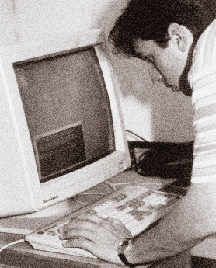
CL: So you thought of using DoWhatDo as a collaborative model to make art?
SLAYTON: I appropriated this DoWhatDo theory and applied it to the process of doing a community-based performance work. I would literally get all the participants engaged in this DoWhatDo-ing with me with their full knowledge
CL: Were the conversations prior to the performance itself?
CL: Did you limit the conversations to performance and community?
CL: Or 'where can we do it?'
SLAYTON: A year leading up to the actual show called "DoWhatDo."
SLAYTON: Right. At a table I would have someone representing the legal interests of the city, I'd have another person from the arts commission representing the arts and where they should take place, and myself, with the objective of identifying the site for the performance. And they'd say, "Well, where do you want to do it?" and I'd say "Well, where do you want me to do it?"
SLAYTON: Do what? It would cycle around so that one person would say something, the next would subtract something, and so on. I would apply principles from DoWhatDo theory to the conversation and get rid of extraneous and useless information.
CL: So you're satisfied with the DoWhatDo collaborative model?
SLAYTON: Yes. It works great.